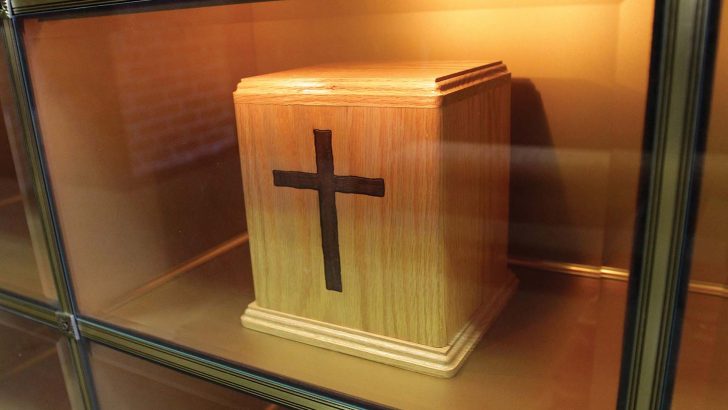Catholic business Eternum Columbarium wants to provide a dedicated space for cremated remains, Ruadhán Jones hears
The number of people opting for cremation instead of burials has risen steadily in Ireland and Northern Ireland over the last 20 years. In 2019, the figure sat at just under a quarter (22%) of deaths ending with cremation for both regions. Given that 79% of people in the UK now opt for cremation, it is only likely that this will increase, with Catholics proving no exception.
Historically, the Church has had a tense relationship with the practice due to the importance it places on a bodily resurrection. Up until 60 years ago, cremation was prohibited. Today, the Church recognises no doctrinal opposition to the practice, while maintaining a preference for bodily burial.
However, on one thing it is insistent – that the ashes be placed in a sacred place so the deceased is not excluded from prayers. This is a tricky proposition at present, with limited availability of spaces in Catholic institutions.
With this in mind, an enterprising young Catholic has set up a business to fill the gap. Eternum Columbarium, founded by Joseph O’Neill, works in partnership with parishes and churches to establish a columbarium – a room for storing funeral urns – for their local community.
“The idea came years ago in 2009,” Mr O’Neill begins. “First off, there was a church in Belfast, St Malachy’s, and the parish priest was having it renovated. He found space under floor and sold it off for urns. Then a Down and Connor priest installed columbarium in his church.
“I thought it was a good idea and something I could do as a business. He said absolutely, we’re going to need more and more of these, given the lack of burial space and more and more people choosing cremation, and Catholic attitudes to cremation changing.
“In 1964, the Church made its position clear, saying it has no doctrinal objections to cremation as it doesn’t change anything for the person after death. But the ashes must be kept whole, they can’t be scattered or kept home, and so they have to be kept in a columbarium.”
Interested
Mr O’Neill found that a number of churches were interested in setting up a columbarium for their parishioners. However, the parishes found them expensive to set up and manage, he explains: “They don’t have the resources to set up a columbarium, so I work in partnership with them. It doesn’t cost the parish anything, I cover the costs, but we split any profits then.”
Eternum Columbarium’s first venture is set to launch September 11, when a new columbarium will open in Ennis Cathedral.
“I’m excited for the launch, we’re hoping to open September 11, and it’ll be installed that week,” Mr O’Neill tells me. “Already, even though I haven’t advertised it except in parish bulletin, 100 niches have been reserved. It’s in the old mortuary chapel, which can fit 240 niches, each of which holds one urn. That means almost half have been sold already.”
Setting up the columbarium is a process covered under Canon Law, and there are specific requirements for where it can be placed. “There are various rules – for instance, it can’t be in the main isle of a church,” Mr O’Neill continues. “It has to be in a side-chapel or a basement or, say a porch area. Not all churches will be able to install them.”
That being said, Mr O’Neill is hopeful for the future, and already has plans for a second collaboration in Donegal. A number of religious congregations have expressed interest as well.
“The options are limited for columbarium now, and they all look fairly similar,” Mr O’Neill says. “The ones that I install are made in Ireland, out of bronze face-plates, they’re made by local artists, and are well thought out. The one in Ennis is based on the cross of St Seanan, found on a local island. The mortuary chapel also has a nice mosaic of Our Lady in blue and gold, so we have sought to integrate that. I do have hope for the future.”
A prominent Irish theologian shares Mr O’Neill’s hope, though on a different line. Dr John Murray, a lecturer in moral theology at Dublin City University, says that it is important that the communal aspect of Catholic funeral traditions is not lost. More than this, he believes positive action should be taken to promote this communal aspect.
“I do think it’s important for the Church in a positive way to emphasise the value of a church as a place, like the one in St Malachy’s for example, where the link with the Church as a community is strong,” Dr Murray says. “Where there’s a strong sense of tradition and a link back to the past and to the tradition that we have around funerals and burials and remembering the dead, and praying for the dead.
Special place
“I think it’s a good idea to have a special place set aside in a church or as part of a Catholic graveyard for Catholics to make use of in dealing with the remains in the form of the ashes after a loved one has been cremated. Rather than the purely private matter of scattering them in the countryside or in the sea or keep them at home or do something else with them than what’s purely private.”
Dr Murray points out that cremation is relatively recent in the Catholic Church, and believes efforts should be made to integrate the practice into the traditions of the Church.
“I think the Church could emphasise the positive aspects of why we would encourage Catholics to have a deep love and respect for the tradition and traditional ways, adapting them for modern needs as well. Doing something positive, not even speaking about it, but doing it, giving people options that will help them to know what to do and to be comfortable and happy doing it in a way that is traditional, but in a new way.”
Looking at the example of Ennis cathedral, Dr Murray adds that he thinks linking with the cathedrals is good too, as it provides a connection between the community and the diocese.
“There’s something special about a cathedral as a central church of a diocese. There’s a sense of importance in a cathedral. But it could be any church, a lot in the past would have had graveyards beside them and the link would be quite strong visually, a sign and symbol for people. The link with cathedrals would be good in that way too, linking the community and the diocese,” he finishes.


 Ruadhán Jones
Ruadhán Jones An urn containing cremated remains is seen in a niche
in the Holy Rood Cemetery mausoleum in Westbury, New York, in 2010. Photo: CNS.
An urn containing cremated remains is seen in a niche
in the Holy Rood Cemetery mausoleum in Westbury, New York, in 2010. Photo: CNS. 